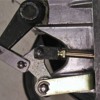Quickitty, adjusting the Pantera clutch is not the most fun part of ownership. And tolerances are smaller than on most other cars. And if you have effort reduction kit, tolerances are even smaller. Below is a paste of my experience on this, hope it helps:
-----
FWIW, here’s a summary of how to adjust the clutch on the Pantera. Being used to automatic transmissions for decades, it was a new and complicated world that opened up to me when I bought a Pantera with a hydraulic clutch and especially how to adjust it. Having bought all the literature I soon found inconsistencies. I’ve read many sources including the Instruction Manual, the TSB, PanteraPlace and others. And they were quite different. I think now I finally understand how to do it, and if it can help others, below is the short simple (?) method I’ve used
First, the basics have to be right: A good master, slave, pipe and line. And a proper Pantera clutch, not just a Mustang clutch. Some recommends a long-throw slave, and that will make getting the right adjustment easier. But it’ll also increase clutch pedal effort, something you don’t want (except if you want to discourage the wife from driving ). And the fluid has to be free of air.
1. Master: pedal should be adjusted so at rest it’s between 0-½” closer to the driver than the brake pedal. Then test with a friend that with the pedal fully pressed down, there should be at least ½” gap to the firewall/carpet
2. Clutch axle arm: the almost vertical arm from the ZF to the slave rod end. Imagine a straight line from the clutch axle on the ZF up to where the clevis pin is. That line should be 90 degrees towards the slave. Ideally it should be 90 degrees when the clutch pedal is half pressed down. Any other angle will result in that the slave rod movement translates into less movement of the clutch axle. Maybe you should move it a notch? Also check that there’s free movement, when the clutch pedal is fully depressed, does the arm or the bolt/nut perhaps rub on the ZF? And get a proper size clevis pin, previous owner had just used a bolt that was 0.3mm less in diameter
3. Slave return bolt: Temporarily remove the spring. Use your hands or a tool to move the clutch axle arm rearwards, and feel for when it hits the resistance of the clutch. Should be easy to feel. While holding the arm in that position, turn the screw so that it almost touches the bracket, leaving a 2mm gap. This will ensure that a. there’s no wear on the clutch release bearing when the pedal is not pressed down, and b. that you get as much movement of the clutch as possible. Reinstall the spring
4. Slave rod: Some suggest that the rod is used to position the resting position of the clutch axle arm and that the return bolt should be thrown away. And some say this is not good, because the slave should not bottom out. I think the best is to use the return bolt as described in 3., and then adjust for almost maximum slave piston travel on the rod. Almost, so with no bottoming out. With the system at rest, take out the clevis pin and by hand press the slave rod all the way up in the slave. And then release 1mm. Do the holes now align so the clevis can be put back in? If not, adjust the length of the slave rod, so that they do
With all this done, you should have a clutch that neither slips nor grinds teeth. And of course you must press the clutch pedal all the way down every time. Happy shifting!
-----
Yeah, you wish for that automatic



